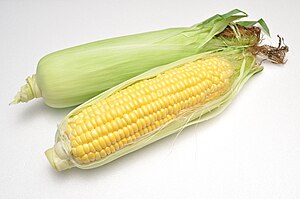Cookbook:Corn
| Corn | |
|---|---|
 | |
| Category | Vegetables |
Cookbook | Recipes | Ingredients | Equipment | Techniques | Cookbook Disambiguation Pages | Ingredients
Corn or maize is a grain from North and Central America.[1]
Characteristics
[edit | edit source]An "ear" of corn takes the form of a central core or "cob", with rows of kernels along the outside, covered in a layer of silky strands and all enclosed in several layers of leafy husk.[2][3] The color of the kernels ranges from white to yellow, red, or blue/purple, depending on the variety.[4][5] The kernels range from starchy to sweet, depending on the desired use.[6]
Corn is either eaten as a vegetable when fresh or dried and processed to a variety of corn products, including corn meal, flour, starch, oil, and syrup. When nixtamalized with alkali, corn is turned to hominy, which changes the flavor and makes its protein and vitamin content more available.[2][7] It also allows the corn to be transformed into a cohesive dough.[8]
Varieties
[edit | edit source]
A few broad varieties of corn exist, largely used for different purposes:
- Flint corn: small and starchy kernels, with tough exteriors;[2] usually dried and ground or turned into popcorn[9][8]
- Dent/field corn: large and starchy kernels with a characteristic divot in them;[2][8] usually dried and ground or processed into corn syrup[2][8]
- Sweet corn: soft and sweet kernels; used fresh as a vegetable[2][8]
- Baby corn: sweet corn picked when very immature and tender; eaten whole, cob and all[8]
- Flour corn: large cobs and starchy kernels with a thin exterior;[2] usually ground to flour[10]
Selection and storage
[edit | edit source]When selecting fresh corn, look for green husks with no browning, sliminess, or mold.[5][6] The silk will have some browning at the top, but it should not be excessive or decaying.[3] The kernels should be plump and juicy.[6] Avoid husked corn if you can.[5] The corn can be stored for a few days in the fridge, but its sweetness will decrease as you let it sit, and it's best fresh.[3][5] Frozen and canned sweetcorn is also available.[3][11]
Preparation
[edit | edit source]Usually, the first step when working with whole sweet corn is to peel off the husk and break off the remnant of the stem at the bottom of the cob.[6] The corn silk then needs to be removed, which can be done by rubbing with a brush, towel, or hand to dislodge.[3][5] The cob can then be cooked on the cob, or you can use a knife to cut the kernels off the cob and work with them separately.[6]
Use
[edit | edit source]Corn can be served fresh as a vegetable, or used as a grain.[12] Sweet corn can be quickly cooked by steaming, boiling, grilling, or roasting before eating on its own.[1][3][11] Individual kernels may also be incorporated into other dishes, such as salads, succotash, and baked goods. Dried corn kernels can be cooked like other dried grains, and other downstream corn products have myriad uses.[11]
Recipes
[edit | edit source]References
[edit | edit source]- ↑ a b Thaler, Maximus; Safferstein, Dayna (2014). A Curious Harvest: The Practical Art of Cooking Everything. Quarry Books. ISBN 978-1-59253-928-4.
- ↑ a b c d e f g Davidson, Alan (2014-01-01). Jaine, Tom (ed.). The Oxford Companion to Food. Oxford University Press. doi:10.1093/acref/9780199677337.001.0001. ISBN 978-0-19-967733-7.
- ↑ a b c d e f Labensky, Sarah R.; Hause, Alan M.; Martel, Priscilla (2018-01-18). On Cooking: A Textbook of Culinary Fundamentals. Pearson. ISBN 978-0-13-444190-0.
- ↑ Figoni, Paula I. (2010-11-09). How Baking Works: Exploring the Fundamentals of Baking Science. John Wiley & Sons. ISBN 978-0-470-39267-6.
- ↑ a b c d e Kipfer, Barbara Ann (2012-04-11). The Culinarian: A Kitchen Desk Reference. Houghton Mifflin Harcourt. ISBN 978-0-544-18603-3.
- ↑ a b c d e Gisslen, Wayne (2014-04-15). Professional Cooking. Wiley. ISBN 978-1-118-63672-5.
- ↑ Wolke, Robert L.; Parrish, Marlene (2002). What Einstein Told His Cook: Kitchen Science Explained. W. W. Norton & Company. ISBN 978-0-393-01183-8.
- ↑ a b c d e f "The Serious Eats Guide to Corn". Serious Eats. Retrieved 2024-04-21.
- ↑ "Not All Corn Is the Same — Learn About the 3 Main Types with Our Handy Cheat Sheet". Kitchn. Retrieved 2024-04-21.
- ↑ "Specialty Corns | New Mexico State University - BE BOLD. Shape the Future". pubs.nmsu.edu. Retrieved 2024-04-22.
- ↑ a b c Ruhlman, Michael (2008). The Elements of Cooking: Translating the Chef's Craft for Every Kitchen. Black Incorporated. ISBN 978-1-86395-143-2.
- ↑ Wolke, Robert L. (2011-01-12). What Einstein Told His Cook 2: The Sequel: Further Adventures in Kitchen Science. W. W. Norton & Company. ISBN 978-0-393-07982-1.